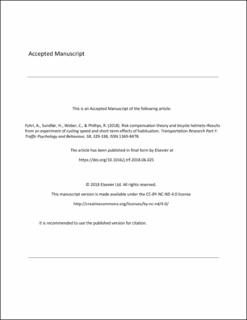| dc.contributor.author | Fyhri, Aslak | |
| dc.contributor.author | Sundfør, Hanne Beate | |
| dc.contributor.author | Weber, Christian | |
| dc.contributor.author | Phillips, Ross Owen | |
| dc.coverage.spatial | Norway | en_US |
| dc.date.accessioned | 2021-08-02T12:09:16Z | |
| dc.date.available | 2021-08-02T12:09:16Z | |
| dc.date.created | 2018-09-19T14:25:36Z | |
| dc.date.issued | 2018-06-30 | |
| dc.identifier.citation | Transportation Research Part F: Traffic Psychology and Behaviour. 2018, 58 (October), 329-338. | en_US |
| dc.identifier.issn | 1369-8478 | |
| dc.identifier.uri | https://hdl.handle.net/11250/2765854 | |
| dc.description.abstract | It has been suggested that the safety benefits of bicycle helmets are limited by risk compensation. The current study contributes to explaining whether the potential safety effects of bicycle helmets are reduced by cyclists’ tendency to cycle faster when wearing them (as a result of risk compensation), and if this potential reduction can be associated with a change in perceived risk. A previous study (Fyhri & Phillips, 2013) showed that non-routine helmet users did not increase their speed immediately after being given a helmet to wear, while routine helmet users cycled more slowly. The current study tests whether the previously found reduction in speed in response to helmet removal – as an indirect indicator of risk compensation – could be established in non-routine helmet users, after a period of habituation while cycling with a helmet. We did this by conducting a randomized crossover trial, in which we used GPS-derived speed calculations and self-reported risk perception. To test the effect of habituation, we used a design where each participant took part in two rounds with a break between and each round having two trips. We collected the data in June 2015. Non-routine helmet users (N = 31) were recruited in the field (along cycle routes in Oslo), and through a sample drawn from the Falck National register of bicycle owners. In the first phase of the study, all participants were asked to complete a test route (2.4 km downhill) with and without a helmet. In the second phase of the experiment, conducted after 1.5–2 h, the same participants again completed the test route with and without a helmet. In the time between the first and second phases of the experiment, all participants were given helmets, and told to use them on a predefined bicycle route. Habituation to the helmet between the first and second phases of the experiment did not produce any decrease (with helmet removal) in speed, on top of the habituation that occurred while cycling down the hill (the order effect). Mean speed difference for cycling with/without a helmet before the break was −0.76 km/h, after the break this difference was 0.32 km/h; 95% CIs [−0.5, 2.9] and [−0.9, 1.5]. We argue that risk compensation is an unlikely effect of using a bicycle helmet, and probably cannot explain any adverse effects related to helmet legislation. | en_US |
| dc.language.iso | eng | en_US |
| dc.publisher | Elsevier | en_US |
| dc.rights | Attribution-NonCommercial-NoDerivatives 4.0 Internasjonal | * |
| dc.rights.uri | http://creativecommons.org/licenses/by-nc-nd/4.0/deed.no | * |
| dc.title | Risk compensation theory and bicycle helmets – Results from an experiment of cycling speed and short-term effects of habituation | en_US |
| dc.type | Peer reviewed | en_US |
| dc.type | Journal article | en_US |
| dc.rights.holder | © 2018 Elsevier Ltd. All rights reserved. | en_US |
| dc.description.version | acceptedVersion | en_US |
| cristin.ispublished | true | |
| cristin.fulltext | postprint | |
| cristin.qualitycode | 1 | |
| dc.identifier.doi | 10.1016/j.trf.2018.06.025 | |
| dc.identifier.cristin | 1611114 | |
| dc.source.journal | Transportation Research Part F: Traffic Psychology and Behaviour | en_US |
| dc.source.volume | 58 | en_US |
| dc.source.issue | October | en_US |
| dc.source.pagenumber | 329-338 | en_US |
| dc.relation.project | Norges forskningsråd: TRANSIKK | en_US |

